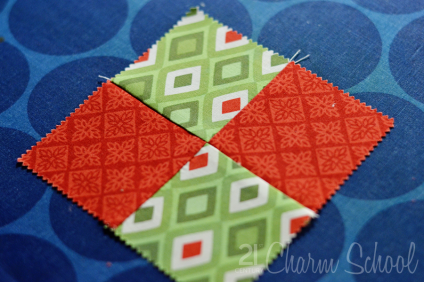 Piecing a perfect four-patch block is just one of those things a quilter should have under their belt, if you know what I mean. Luckily, it’s a quick and easy process (nevermind that it took me about a billion pictures to show how easy it is…). Once you get the hang of it, you can crank these babies out in no time flat, and you’ll want to, they’re in a TON of patterns. I apologize in advance for these colors. They’re pretty much clashing with everything else here…
Piecing a perfect four-patch block is just one of those things a quilter should have under their belt, if you know what I mean. Luckily, it’s a quick and easy process (nevermind that it took me about a billion pictures to show how easy it is…). Once you get the hang of it, you can crank these babies out in no time flat, and you’ll want to, they’re in a TON of patterns. I apologize in advance for these colors. They’re pretty much clashing with everything else here…
Start with 4 squares of fabric, all the same size.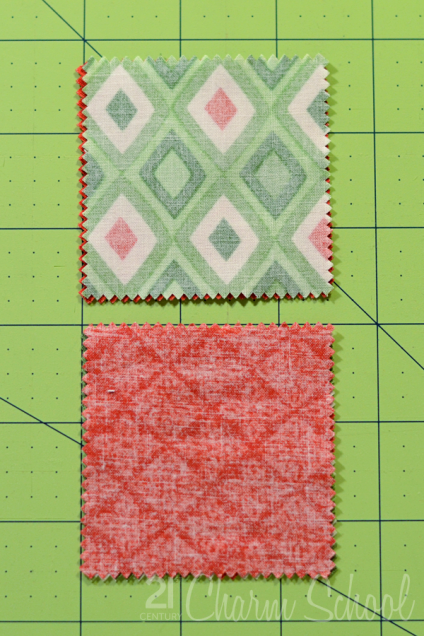
Take the squares on the left and flip them over so they are face down on top of the fabrics on the right. The “right sides” of the squares should be facing each other. In quilting terms, this is called “right sides together”. I know, we’re a creative bunch. Pin, if necessary. My squares are only 2½” square, so it’s not needed in my case, but if you’re working with squares bigger than about 3″, I suggest pins.
Using a 1/4″ seam allowance, sew both sets of two squares together using a straight stitch. To make things easier later, do NOT take a double stitch or backstitch on the first and last stitches.
They’ll look like this. Only with your fabrics, of course.
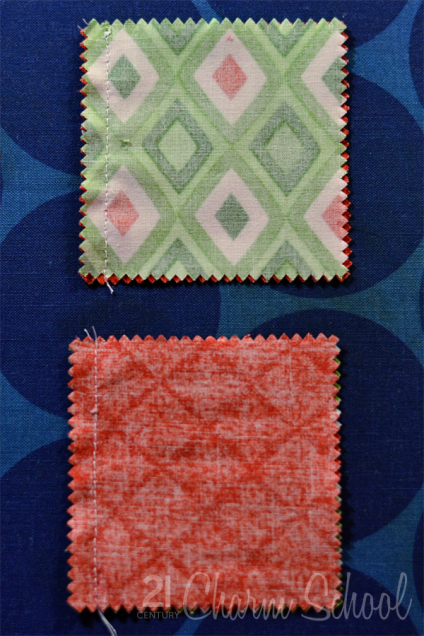 Put your sewn squares on your ironing board without opening them.
Put your sewn squares on your ironing board without opening them.
Press the seam allowance with a hot iron. I know this seems weird, but it’s called “setting” the seams. It makes the thread lay more flat so that when you open up the block and press it, it lays, well, more flat.
See? Looking flatter already.
Now, open up your pieces and lay them face down.
Decide which way you will press your seam allowance. Ideally, you will press in opposite directions, toward the darker fabric. So, see how the block on top is being pressed to the left, while the block on the bottom is being pressed to the right? This makes it really easy, later on, to make a perfectly aligned intersection. To make sure you don’t “lose” any fabric in the seam, gently pull both sides of the block away from the seam while using your fingers to press and hold the seam allowance the direction you will press it with the iron. Work slowly and carefully so you don’t skew or stretch your blocks.
Press with hot iron.
Now, place the right sides together again. You will notice that your seam allowances are facing different directions, directly opposite each other. You will also notice, that if you use your fingers to gently slide the blocks against each other, you can feel when the block “clicks” into place. This is usually called “butting” or “nesting” your seams, and is a great way to not only get precise intersections, but also to distribute bulk.
Pin. Usually, I will pin at the top, at each intersection, and at the bottom. If there is more than 3 inches or so between, I will pin there, too.
Using a 1/4″ seam allowance, sew. Be sure to remove your pins before they go under your presser foot.
Lay flat on your ironing board, and set the seam.
Open up the block, face down on your ironing board. Push the seam allowance in opposite directions on the top and bottom.
Since you didn’t take any backstitches before, pushing the seam allowances will loosen those middle stitches, allowing them to come out and open up, like this. Isn’t it cute? Besides being cute, it is also much flatter than pressing your seam allowance all to one side. (There ARE situations where that is a better option, though, so follow your pattern’s instructions.)
Press it. (And when I say press it, I mean pick up your iron, and place it on the block. Straight down. Don’t move it around. That will just stretch and warp your block.)
Now, flip it over, and give it one more press. Voila! A perfect four-patch block!
I knew you could do it.
Any questions? Tips or tricks? Share!

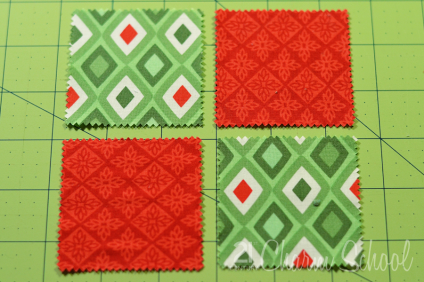

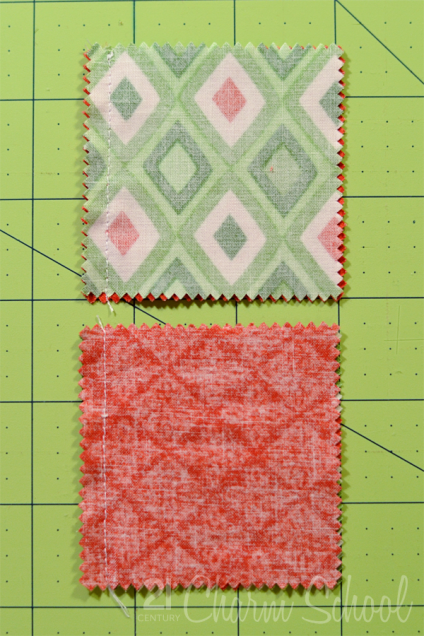
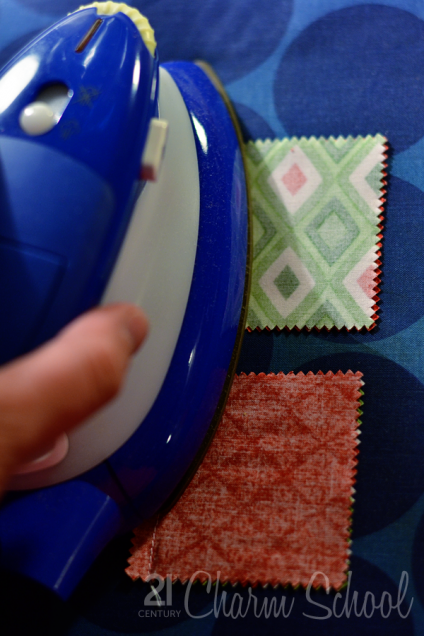
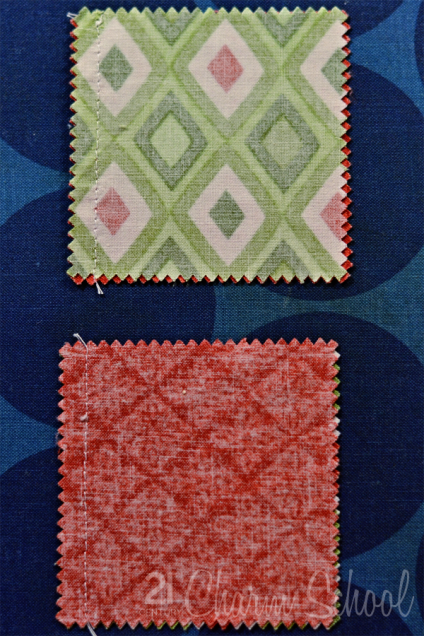
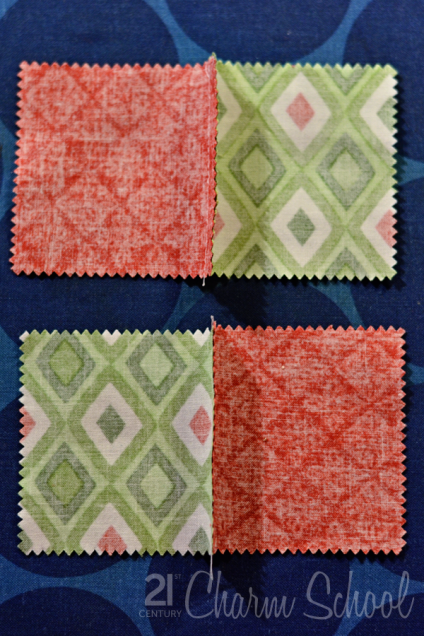
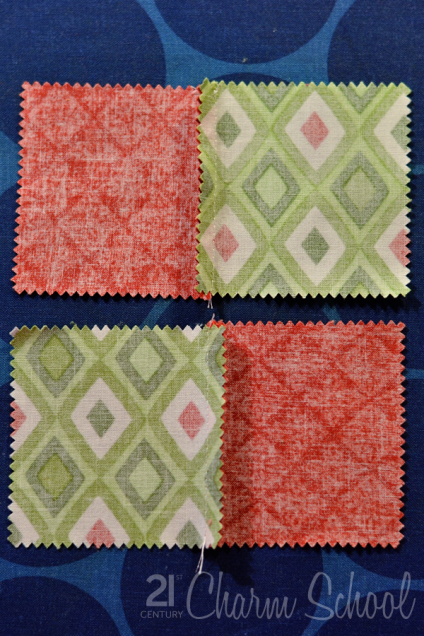


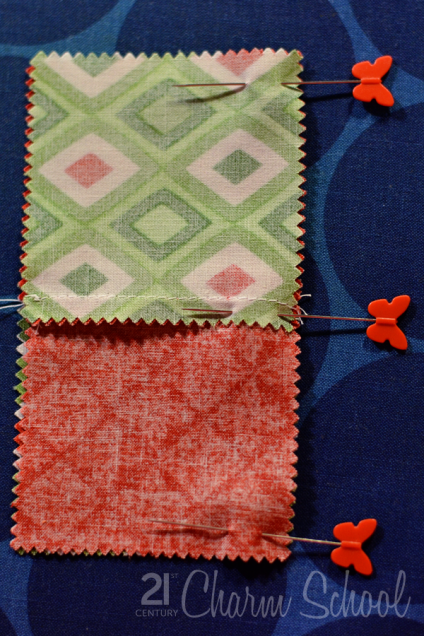
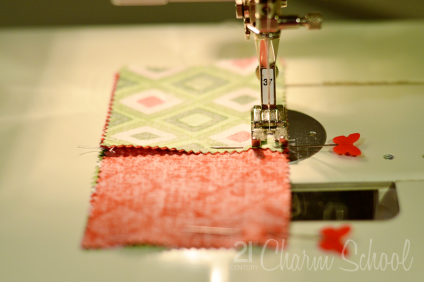
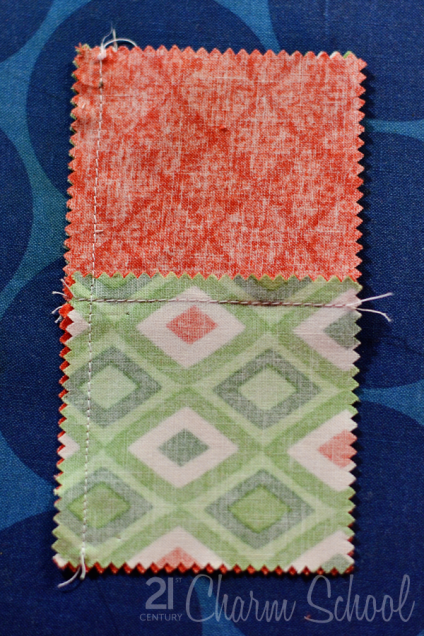
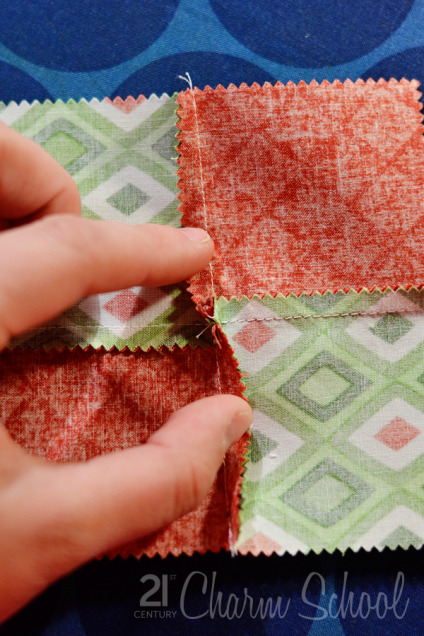
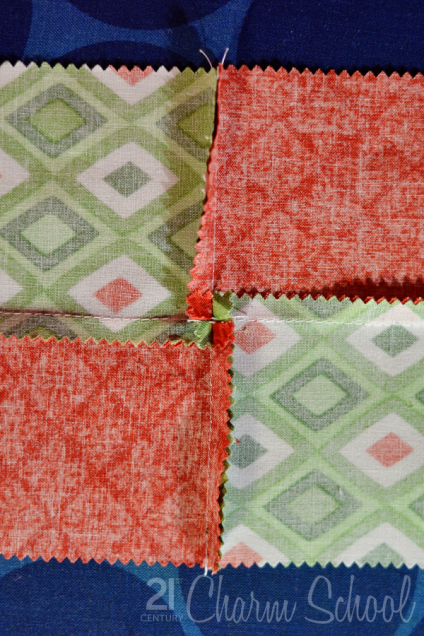
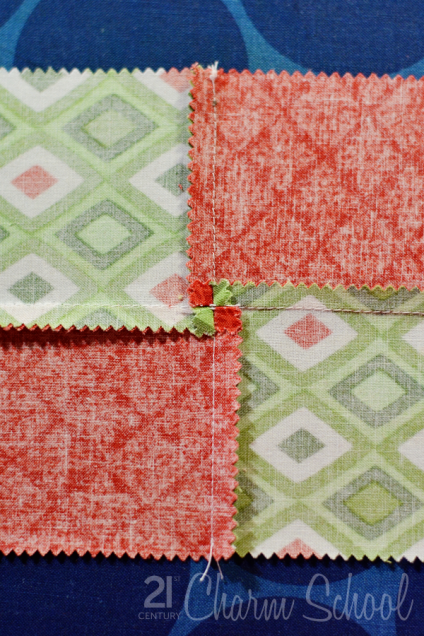
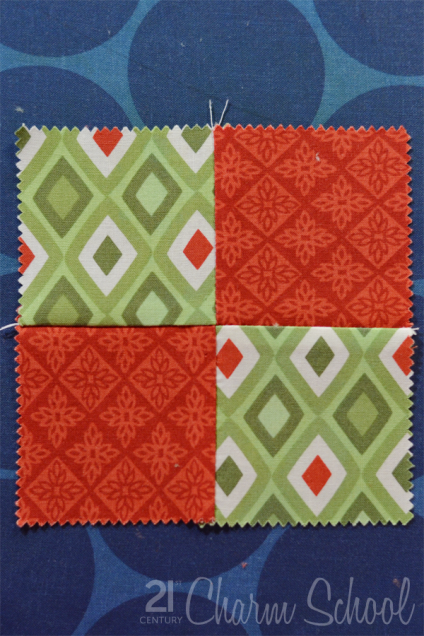
Love it! It’s the little details that make all the difference!
Thanks so much for this share. til next time, susie.
Thanks. I do love this. Please send me more tips.
I love it thanks please more ideas
So glad an old dog can learn new tricks. This is so easy and looks do good. Thanks
Thank you so much! You can teach an (old) new dog new tricks too!
Thanks for the tips! Photos are very helpful.
Cheers!
This is EXACTLY what I was looking for! Great tutorial, and one can never have enough photos!! Thank you for sharing.
I LOVE the simplified approach with step by step pictures. Great job. It really helps a beginner like me.
I see you share interesting content here, you can earn some additional cash,
your blog has big potential, for the monetizing method, just type
in google – K2 advices how to monetize a website
This seems like a lot of work. It is flatter but this is time consuming when making a very large quilt.
This is a great technique so depending on how you are quiltng it, it will make that process much easier because the joints are flatter. So, if you are tying the quilt this won’t make a difference, BUT, if you are ‘free-motion’ quilting or using a walking foot with a close or tight design or stitch-in-the-ditch quilting, it will make it much easier and there will be a difference you can see! Having said all that, you might also want to keep in mind what the quilt is being used for and if you want to take the extra step and time. The only other way I know of to get as flat of a joint would be to press the seams open and that is far more fussy to do!
Thank you. I supposedly know all of that, but you really made it easier for me to remember that! I had forgotten how important this method is until you emphasized for me in a clean, clear visual. :)
Thank you very much for this tutorial !!!!
Great instructions! Love the pics to go with it!
love the instructions easy and perfect to see how to do things
Thanks, this is brilliant; I have only made one patchwork quilt and it was such an epic that I was put off trying again but with this advice I think I’ll give it another go!
Is it best to start with four squares and then add more if you want a bigger block or is it a different technique all together for bigger blocks?
Good question!! I inquiring minds want to know! ?
Great tute!
Great tutorial and pictures!! I’m going to try this today. :)
This is a great tutorial for beginners! Wonderful images!
Thank you so much. I’d never thought of putting them face down to press. Just found your page… I will be a follower!
I love your descriptions! You made me laugh! Love it!
I
thought I was so smart. But I am never to old to learm new tricks. Thank you for making this so easy.
That was brilliant, thank you for such clear instructions. I am new to patchwork and this is my first successful “butting”. A very useful tutorial that I will use over and over again.
Thanks for the tip. Great tutorial.
Loved it!!!
By not back stitching it makes the 4 patch so eay to go together. I could never get the little square to be square and now it will be easier. Thank you.
Qué buen tutorial, muchas gracias.
Wow, thanks!
This will come in handy when I make my first one. I am a beginner at sewing, but I want so bad to make a quilt. This helps a lot. Thank you!
Thanks for sharing information. It makes such a difference when you know what to do. Thanks again. I am new to quilting and loving it.
i love all the details you provided! I’m rather new at quilt making and want to start out doing it right. Thanks!
I love it! Even better is how you detail everything so even us slow people understand. Please send me all your “help”. Can’t wait for the next thing you teach me! Tnank you
Excellent tutorial. There are few bloggers who insert so many of the finer details – those things that take a project to the next level. I’ll have to check out your other work!
Thanks for this. As a newcomer to quilting this step by step tutorial is really helpful and just what I need.
Great hint,but you pressed to the dark side in the beginning,but in the end they were reversed so now I know to press to light side in the beginning.
Jo: take another look. The first two seams are the ones that are horizontal in the final picture. They were pressed to the dark side. The final seam, the one that completes the four-patch, is the vertical seam in the final photos. And yes, that seam is split at the intersection and pressed to the two light sides.
Can I just say what a relief to uncover a person that actually understands
what they’re talking about over the internet. You certainly understand how to bring an issue to light and make
it important. A lot more people really need to read this and understand this side of
the story. I was surprised that you aren’t more popular because you surely possess the gift.
Hi there, this weekend is good for me, as this time i am reading this enormous educational post here at my
house.
Lori in CT.
Hello, I would love more of you tricks and tips. It’s always fun learning new tips.
Thank you so much, Lori
Hi
So simple – well it looks simple, I will try this. I love the way that your text was non jargon, it makes a change. When you are trying to learn new things books and articles often confuse you at the first hurdle or discuss it and expect you to absorb what they are saying and bang the next minute the first pattern starts using the jargon!
Thanks for the tut! I just made the best 4-patch ever!!!
Always wondered how they did this, now I know and I have you to thank for it! You are wonderful, many many thanks, Tina (Auckland New Zealand)
Many of us are Visuals. We love demonstrations and pictures. We learn easily this way. You, my friend have a brilliant career in your future!!! Frieda Christianson
This really helped me with my first quilt – thank you!
I am a beginner thks I need this!!!!!?.✂
As a volunteer, I organized two groups and taught quilting locally four times a month for seven years while working full time in government. I ended up with major burnout. Then I faced cancer head on and was blessed to make it through. Now, four years after cancer and retired, the call to teach has returned. I’m back at the sewing machine and making plans. What a difference Pinterest makes when doing research! Finding your tute, reminding me of techniques I once knew, serves as a wonderful refresher course as I jump back into the quilting world. One of the reasons I love quilting is because the people I “meet” in this craft are always so friendly and helpful. Thank you for sharing!!
Enjoyed your tutorial very much. As a retired educator ( I taught Grade7&8family studies aka Home Ec) for 34 years. I was impresses with the simplicity of your Instructions. Way to go!!! You wil make life simpiler for many beginners. I wish I had thought of it but my sewing skills are more advanced than my computer skills. Faye
I’ve recently retired and began quilting to keep a friend company. She was blown away when I produced these 4 patches and asked how I did them so consistently well. Thanks for the tute and for making a very humble guy look good. I think I’ve earned brownie points with the quilting ladies! Love the pics and easy to follow text. Thanks again. Brian.
Thanks for publishing this tutorial. I have had issues getting my corners to line up for years. This has made every square I have made close to perfect! Being self taught this has made my life easier and a lot less stressful making a quilt that was requested. The way you explained each step made it easy to follow. Two thumbs up!!
Olá,adorei as explicações,vou tentar fazer, obrigada.Beijos.
This is by far the best tutorial and the pictures really are the best to see and understand. A heartfelt thank you !
Wish I had a seen this before I started (and finished) my first-ever quilt! (And by “seen this”, I mean taken the time to actually search for a tutorial like this, instead of being lazy and deciding I was undoubtedly an undiscovered quilt genius). I will definitely be using this method next time! Thank you!
Love how you broke down that lesson! As a former teacher myself, I appreciate efficient and concise instructions that make things clear from the beginning. Great job!!!!
Very nice and neat. Doypu knoe how to do a pinwheel with “clean” points? LOVELY!
Love this tutorial. Thanks for sharing. I’ll try for my project.
love this just about to start my first quilt good tutorial .
This was so informative and the details so helpful. This was the best of all I have read/searched. Thank you!
I have checked your site and i’ve found some duplicate content,
that’s why you don’t rank high in google, but there is a tool that can help you to create 100% unique
content, search for; boorfe’s tips unlimited content
Hi April
I’m attempting this technique but I keep feeling insecure, i get the feeling that undoing those stitches will weaken the seam, I’m still new to the quilting world and still looking over my shoulders in case that the quilting police will come and get me for all the infractions I make ;)
The quilt I’m making will be use a lot and wash in the washing machine, what have been your experience when using this method?
Thank you so much for your generosity and gifting your knowledge!!!
Terrific step-by-step and very clear pictures. Thank you!
Thank you so much. I’m a beginner quilter. The step by step way you describe and show pictures for each step makes your lesson so easy to follow and understand!
Wonderful! That was a very educational tutorial! Do you have one for the perfect pinwheel? I have so much bulk and I’m not sure what to do with it
Thank you so much for sharing this VERY very helpful tidbit, also much needed. You’re awesome. I’ll subscribe now.
I’m somewhat of a newbie at quilting (again). Thanks for this instruction! I also loved the droll narrative –
❤️